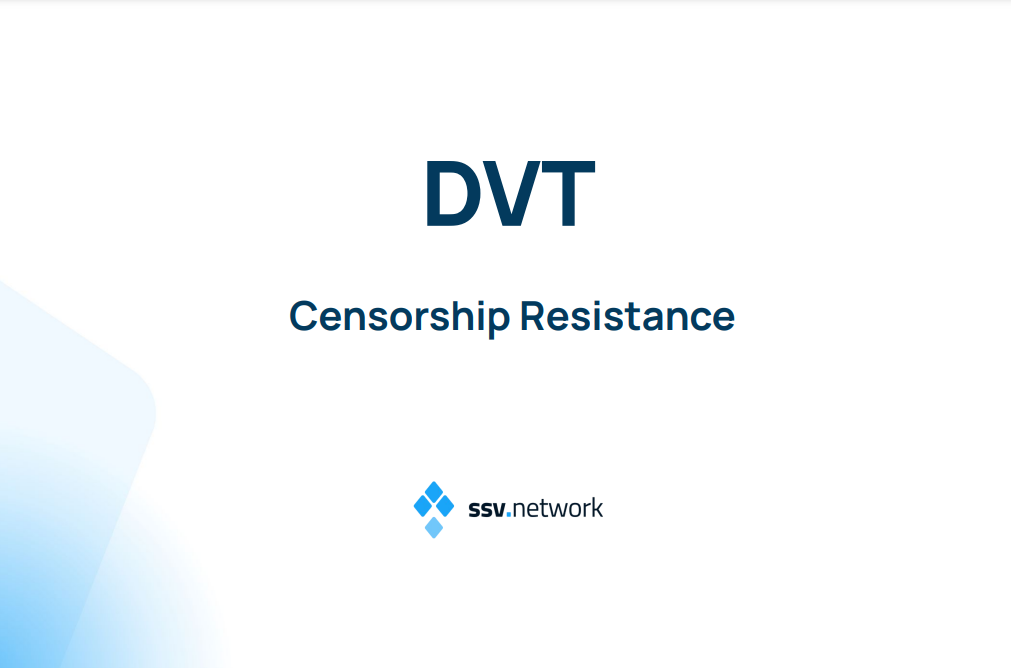Improving Censorship Resistance using DVT - Censorship.wtf
Source : https://www.youtube.com/watch?v=3FK3V3hbWHQ

Intro
This talk is introduced by SSV Netowrk, which is a research project by the Ethereum Foundation to distribute validator nodes into shares operated by independent node operators, aiming to decentralize control over validators.
Distributed Validator Technology (DVT) like SSV can contribute to censorship resistance on Ethereum.
State of ETH staking

There is currently high centralization among Ethereum validators, with 5-6 entities controlling about 55% of the total stake. This is problematic for censorship resistance.
The high centralization creates risks for individual stakers using centralized services as well as systemic risks for Ethereum as a whole, and there are additional risks as well :
- Vulnerability to hacks/accidents
- Disproportionate slashing penalties
- Ability for large validators to censor certain on-chain actions.
Alon (the speaker) wants to focus on explaining 3 reasons why censorship can currently happen on Ethereum.
Causes & reasons to censor



Here are the 3 reasons why censorship happens :
- Malicious attacks, involving someone taking control of a major validator service and deliberately causing censorship, either broadly or for specific transactions. This is usually temporary.
- Regulatory censorship, which is usually forced or self-imposed, targets specific transaction types, evolves over time, and is long lasting.
- Business-driven censorship, which shares similarities with regulatory censorship but is self-imposed, focused on profitability, still specific and evolving, and long term.
All three lead to unequal treatment of transactions, whereas Ethereum should process all transactions equally.
That said, there are solutions and ways to mitigate censorship on Ethereum.
Potential Solutions
Distributed Validator Technology

DVT splits an Ethereum validator into shares that are operated by independent node operators in clusters.
It combines threshold signatures (BLS) with a thin consensus protocol to provide liveness, fault tolerance, and robustness.
Distributed-Key-Generation "DKG"

By adding distributed key generation (DKG), no single entity holds the actual validation key. This provides additional benefits around regulation and responsibility.
SSV's strategy is to combine DVT with DKG to help mitigate censorship risks and bring interesting new properties to Ethereum validation. However, Alon believes this is limited and not very scalable.
Censorship resistant cluster

A new concept is "censorship resistant cluster" : configuring a DVT cluster to reduce censorship ability. Doing this at scale can make a large part of Ethereum's validator set resistant to censorship.
One proposed censorship resistant cluster:
- 4 regulated US institutional staking services for robustness and scale
- 3 solo stakers for diversity
- 7 total validators in cluster
If US regulations later censor certain transactions, the solo stakers would only need 1 of the 4 institutional validators to agree to sign a block with them, making censorship plausable to overcome.
Mixing node operator types provides censorship resistance while still leveraging the robustness of institutional staking services. DVT's fault tolerance also helps solo stakers.
This is an improvement over status quo - today 5 US entities control majority of Ethereum stake making censorship easy via regulatory letters.
Even heavily regulated company like Coinbase could participate in one of these clusters with distributed key generation, abstaining from signing blocks they want to censor but allowing other validators to still sign it.
SSV stats


SSV has been operating DVT on Ethereum testnets and mainnet for years already with no changes needed to Ethereum itself. Signatures are transparent to the blockchain.
Alon believes DVT is a good way to reduce censorship risks without major engineering changes :
- SSV runs a contract-based DVT network of interconnected node operators coordinated through a smart contract.
- Users decide which validators run on which clusters of SSV operators across global data centers.
- Interacting with the network is through a web app
Integrating more independent node operators via DVT is a straightforward way to reduce censorship risks, which are mainly driven by business decisions, regulations, or malicious attacks.